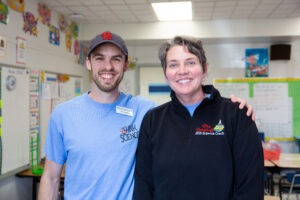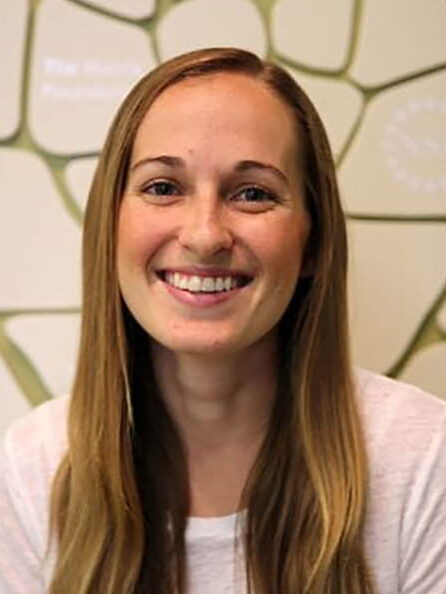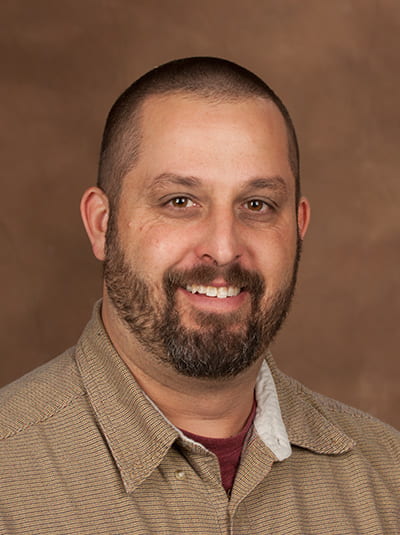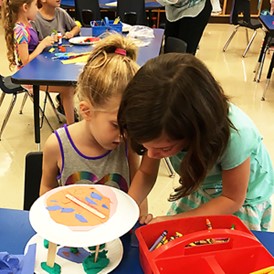Lisa Everett knows an engaged first grader when she sees one.
“Engaged students are actively involved in the learning,” she says. “They are asking and answering questions, using the materials, and discussing the activity with classmates. They are driving their own learning.”
Even with 25 years of experience teaching a full range of grade levels from fourth to twelfth, Everett is keeping her own learning curve fresh. She accepted a new challenge last year: teaching first grade at Armstrong Elementary in the Hazelwood School District. She’s settling in just fine with her youngest set of learners yet, and getting an even better idea of what first graders are capable of understanding. For science, she’s leaning into mySci, a comprehensive kit-based program developed by WashU’s Institute for School Partnership.
“One of the things I really like about mySci is that the curriculum provides a lot of opportunity to move,” says Everett. “Students need to be active. Science is an active subject. They need space and to be able to move. If they can’t move, they won’t retain the information.”
During a lesson on volume and pitch, Everett’s first graders were all in, using palm pipes that came in a red mySci kit packed with supplies that had been delivered right to her classroom. mySci kits come with materials organized and ready to be used for their purpose: to help young learners get down to the business of considering science with all of their senses. They are touching, looking and hearing. They are picking up words throughout the day and using them in the right context.
A fan favorite during this school year, has been the word efficient.
“They love this word,” says Everett. “And they use it correctly. As a teacher, you have to use these words with them. They can learn them. Just listening to young students use the vocabulary, words like vibrations and translucent, in lessons we do later on, to hear them give you information back in a way that confirms they understand, is very exciting.”
Everett and the elementary teaching colleagues throughout her school district get ongoing support with their science teaching from Sara Berghoff, Hazelwood’s K-5 science instructional coach. Berghoff knows a thing or two about teaching and mySci. A former fifth grade teacher in the district, she also helped write early mySci curriculum 13 years ago. She took on the coaching role three years ago and is charged with supporting science instruction in all 19 elementary schools in the district.

That’s a lot of classrooms and a lot of teachers. Berghoff gladly accepts the challenge.
“Students are tested for the first time in a standardized way as fifth graders,” she says. “We’re trying to get all teachers to realize that you can’t just start teaching science in third grade. They are focused on reading, and they should be, but there are ways to introduce science and social studies concepts while they are developing reading skills.”
As she makes her rounds observing and listening to teachers, common concerns surface: limited planning and teaching time, and content knowledge, for starters. But there’s more.
“Teachers are worried about students asking questions that they cannot answer,” she says. “And some have perceptions about student abilities that become a barrier.”

Berghoff enjoys helping teachers discover that they don’t have to know all the answers and that students are actually quite capable of asking good questions. She does this by providing ample resources, and guiding them to a strategy that is prominent throughout the mySci curriculum: a Driving Question Board (DQB).
A DQB is an instructional tool used to generate, keep track of, and revisit student questions as they investigate anchoring phenomena, another feature of the mySci curriculum.
Defined by the Next Generations Science Standards (NGSS) as a real-world event or situation that serves as a central focus for a unit of study that drives student inquiry and connects learning to meaningful context, an anchoring phenomenon can be anything from a volcanic eruption to how a shadow projects shapes on the sidewalk to anything that sparks student curiosity.
All of the mySci units begin with an anchoring phenomenon or problem. At first, the driving question board is nothing but a large blank piece of paper hanging on a classroom wall. It’s just waiting to be marked up with questions from students. Any and all questions welcome. Some are recorded by the teacher with a marker. Students are invited to write them, too. Sticky notes are encouraged. The teacher guides the group through organizing the questions.
Does anyone have a question similar to John’s ? Got a new question? Let’s get it on the board!

“As the class moves through the unit, the teacher helps the group ask themselves if a question from the board has been answered. When it has, it’s moved to a new section of the board. It’s a way to track learning. It’s interactive. The more student writing on the board, the more ownership the kids are going to have,” add Berghoff. “No question is a wrong question to ask.”
While not a quick fix, a DQB centers the discussion, serving as a literal and figurative space for collective thinking and learning. As a coach, Berghoff says one of her many tasks is to encourage teachers to keep the driving question board from becoming an ornament on the wall. She’s gaining ground.
“Hazelwood is a leader in the number of teachers trying to use driving question boards,” she says. “Teachers say, ‘Now I know what to do with those questions!’”
Making mySci even better
Berghoff and Everett are among a handful of educators in the St. Louis region working with the ISP’s team of instructional specialists to pilot mySci units and lessons that will be part of a seventh revision of the curriculum. Revising and rolling out all of the units for Grades K-5, a total of 25 units, is no small task.
Each unit includes five to eight lessons, and a number of essential components: a digital teacher’s guide with step-by-step instructions and links to additional resources, slides, and of course, mySci’s signature red kits, which are packed with everything the teacher needs for hands-on learning experiences.
While not the first time the team has made changes to the curriculum, the Version 7 revision effort has been an all-hands-on-deck effort, involving instructional specialists, curriculum writers, graphic designers, warehouse staff and working educators willing to help the team pilot the lessons and give honest feedback.
“This is the first time we’ve done a full overhaul of every unit,” says mySci Program Manager Lauren Ashman. “mySci is an iterative program. Each year we gather teacher feedback as part of our process of continuous improvement. Patterns observed from years of feedback are the foundation for the changes we are making in Version 7.”
The revision work started in 2022 with three primary goals for the refreshed curriculum: better alignment with NGSS and MLS standards, more accessible and engaging for students of all levels, and easier for teachers to use in their classrooms.
Asking teachers and science coaches from trusted educator partner districts to participate in the piloting process helps the ISP as well as the educators, says ISP Instructional Specialist Alex Gerber. He leads walk-throughs to observe teachers trying the new units, offers quick feedback and supports coaches, including Sara Berghoff, who has been focused on collecting data around teachers’ use of the driving question board.
“All of this helps us to inform ongoing professional development and revisions to the curriculum,” says Gerber, who even comes in with a video camera to capture willing teachers trying out lessons.
Lisa Everett doesn’t mind a bit. In fact, having Alex observe a lesson from the new version of the unit Putting on A Show With Light and Sound was helpful.
“Alex came in, videotaped and observed, talked to the kids and we debriefed after,” she says. “During the debrief, we discussed what worked and where we stumbled. The whole goal is to make the mySci lessons specific and user-friendly. The mySci teacher guides and slides are very easy to use, so teachers don’t have to spend hours preparing lessons.”
Everett also appreciates being able to have ongoing dialogue with the ISP team members during professional learning days or as needed.
“It’s really nice to have Alex or someone else who created the curriculum right there to ask questions. I’m learning more about science all the time,” she adds.
Change: constant, inevitable and good
Lauren Ashman started with mySci in 2016 as a curriculum writer. Nine years later, as the program’s manager, she’s been deeply involved in every aspect of developing Version 7. A former teacher with a lifelong interest in science, she understands the truth about change when it comes to education and the natural world around us.
“Making significant changes to the curriculum can be difficult because there is a lot of continual change in the educational space for teachers, and that creates cognitive overload. However, our understanding of the natural world is also constantly changing as a result of science. With mySci, we need to routinely check that our content is relevant while also meeting teachers’ needs.”
Lauren Ashman, ISP program manager
The mySci program launched in 2005, starting as a supplemental program with three units: Plants, Animals, and Earth–for students in Kindergarten, first and second grades. Supported by the Monsanto Fund, the program targeted nine districts in the St. Louis region, and reached students through Investigation Stations, vans that had been retrofitted to bring science exploration opportunities directly to the students. The program expanded and evolved into what it is today: a go-to resource for high-quality, hands-on K-8 science instruction. Each year, more than 13,000 mySci kits are delivered to 265+ schools across the region.
Building, assembling and delivering that many kits is serious business. When curriculum writers come up with a new idea, it’s up to ISP’s Distribution and Warehouse Manager Chris Cella to figure out if it’s possible to turn ideas into something that’s scalable.

“The biggest question is this: Can we source the items they want?” says Cella. “We need large quantities to create that many kits. I’m talking big quantities. Where can we consistently get 10,000 sugar cubes at a time, dominoes by the hundreds of thousands, pipe cleaners by the millions?”
Cella was there to build the first mySci kit and now manages a full warehouse team responsible for building, delivering, retrieving and refurbishing the kits.
“The team moves an incredible amount of materials,” adds Cella. “At any given time, there are roughly 7,000 kits outside the warehouse. We work two quarters at a time. In March, we’re already building for the first quarter of the next year. When the kits come back from the schools for refurbishment, it looks like they’ve exploded! It’s our job to make each kit brand new again. We repair what we can and continually refine our systems.”
Like Cella, ISP’s Resource Center Coordinator Diane Pilla remembers mySci’s earliest days. She was there, too. After serving as the science materials coordinator in the Riverview Gardens School District for ten years, she already understood the value of hands-on learning.



“I was working the science nights/events at schools, and Chris would make sure the Investigation Station vans were waiting there for us,” she says. “I guess you could say I was an early face of the mySci program. I started out in the business world, but have been supporting science learning for a long time. I’ve always felt like it’s my job to do anything I can to make things easier for the teachers. The program has grown and changed over the years, but I still want the same thing. I want our customers to feel comfortable, like they are getting the best possible response from us. They are doing really important work, introducing students to science. The whole world is science!”
In recent surveys, 91 percent of teachers reported that mySci makes it easier for them to teach science with confidence. By shifting the purpose of learning science from learning about to figuring out, the program helps students understand the world around them.
“Helping students make connections to their own lived experiences is one valuable part of mySci’s approach,” says Ashman. “That’s a great entry point for students into the units, but we want to give them both mirrors and windows. We also want to open up the larger world to them, to help them consider the experiences of others. In doing so, we create robust learners. Some of our units are hyper-focused, while others take you away from what is relevant to you. It takes you out of your bubble, and that’s a good thing.”

